You probably already how to play D major in the basic open position. Why learn more ways to play D major on baritone ukulele?
- To make faster chord changes. (I explain all my tricks for faster chord changes in this article.)
- To control the high note to form a melody, called chord melody or chord soloing.
- To control the low note (the bass note), which gives the chord a slightlly different flavor and lets you make interesting bass lines with the low notes.
D major is an important chord because the note D is the the lowest note you can play on baritone ukulele (standard tuning). Your lowest string, the D string, when played open is the D note below middle C on the piano.
Did you know? On traditional ukes (soprano, concert, tenor), the lowest note you can play is middle C, almost a full octave higher than the lowest note on baritone uke.
In this article we cover five different ways to play a D major chord. At the end, I’ve included an Appendix for Theory Nerds, to show where a D major chord appears in the keys that you’ll typically be using on baritone uke.
If you need to review the five basic major chord shapes in their open and moveable shapes, check out this article with lots of full-color diagrams.
D Major – Option 1
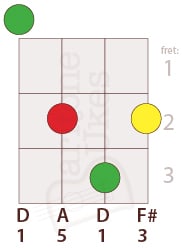
Option 1 is the basic open position for D major on baritone ukulele. In this position, you have the root note on the bottom with the open D string.
In terms of scale degree, from lowest to highest, the notes are 1-5-1-3.
This chord shape can sometimes feel a bit awkward to fret. Choose your fingering option depending on which chord comes before or after the D:

Here is the music notation:

D Major – Option 2
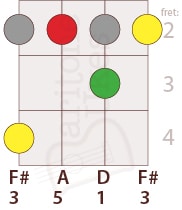
Option 2: On the 2nd fret, use the moveable C shape to make a D major chord. This shape has an F# note on the bottom. Compare to option, with the D note on the bottom. Play each on your uke, paying special attention to the sound of the lowest note. Hear the difference?
Option 2 is a moveabe shape, making it handy for moving around the neck. From here, it’s very easy to get to a Bm by simply lowering your pinky onto the G string, like this:
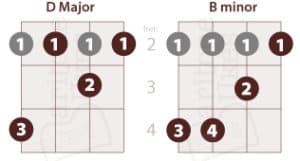
This move is very useful in the key of D because Bm is the most common minor chord in the key of D. In terms of scale degree, D major is the root or the I chord, and Bm is the vi.
And because these shapes are moveable, you can use the shapes shown above to move quickly and easily between the I and the vi in any key, without changing frets and without moving your hand—just move your pinky up and down on the G string.
Here’s how option 2 looks in music notation:

D Major – Option 3
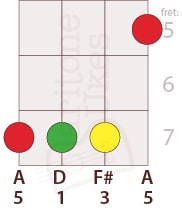
Option 3: On the 5th fret, use the moveable A shape for another way to play a D major.
Move this shape back back two frets (toward the nut) to play a C major chord, a move that you will need very often. Virtually every song in the key of G—the most common key for guitar and baritone uke—involves switching between C major and D major chords. Why? Because C and D are the IV and V chords in G major.
Move this shape up two frets (toward the bridge) to play an E major chord. This move happens frequently in the key of A, because D and E are the IV and V chords in A major.
Here’s what option 3 looks like in music notation:
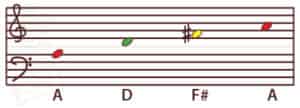
D Major – Option 4

Option 4: On the 7th fret, use the moveable G shape to play a D major chord.
You might use this option in chord soloing when you need a D note on top.
Intermediate players: here’s a quick way to switch between a root chord and the V7 in that key. Move two frets back toward the nut, with a slight change in fingering:
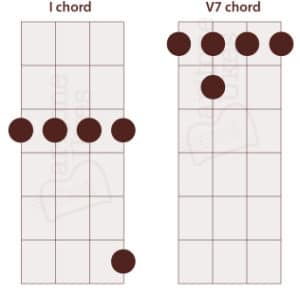
Start on the 7th fret to use this move for D major to A7. This move—from the I chord to the V7 and back to the I—happens a lot in popular music. Try it on your uke and you’ll instantly hear why.
Here is option 4 in notation:
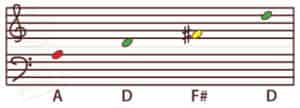
D Major – Option 5
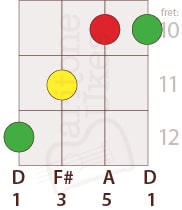
Option 5: On the 10th fret, use the moveable E shape to play D major.
You can quickly switch between D major and Dsus by slipping your pinky onto the G string at the 12th fret, like this:

Notice that you don’t need to move any part of your hand or any other fingers to make this chord change. Just move your pinky up and down on the G string.
Here is what option 5 looks like in music notation:
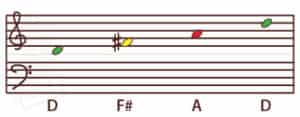
How to remember the order of the chord shapes as you move across the neck
Let’s review the options above:
- open D shape – open position
- moveable C shape – 2nd fret
- moveable A shape – 5th fret
- moveable G shape – 7th fret
- moveable E shape – 10th fret
You can easily remember the order in which to use these shapes with the word CAGED. To play D major chords across the neck, start with the D shape at the “zero” fret. Then proceed up the neck with the other shapes in the order of the word CAGED. So you would get D-C-A-G-E. The sequence repeats starting on the 12th fret.
This order works for every major chord. For example, to play C major chords across the neck, start with the C shape on the “zero” fret, then continue the sequence of shapes in the order of the word CAGED, so you would get C-A-G-E-D.
In the key of C, you beging with the C shape, and continue with the letters in the same order as above: C-A-G-E-D.
This is called the CAGED method.
For more options for playing chords across the neck, check out my article about the CAGED method for baritone ukulele. I spent weeks on those illustrations. Hope you find them helpful!
Appendix for Theory Nerds
This chart shows you where a D major triad occurs, in terms of scale degree, in the six easiest keys for baritone ukulele.
I recommend focusing on the easiest keys for baritone uke, and using a capo if you absolutely must play in other keys.
Some ukulele and guitar teachers recommend focusing on just two keys, C major and G major. I think that’s a great idea, for starters. But for baritone ukulele, I also recommend working with the key of D, because D is the lowest note on your bari uke.
But, at the most, I would stick to the six easiest keys for baritone ukulele.
Getting back to our D major triad chord and the 5 options shown above, any particular major chord functions as a different scale degree in different keys. Like this:



0 Comments